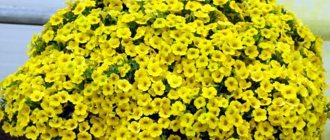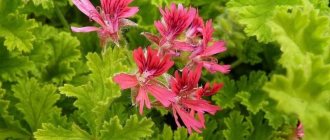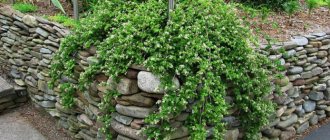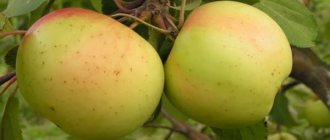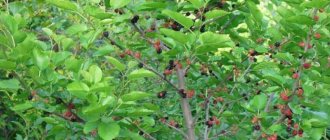Wintering carnations in the middle zone
Most gardeners prefer to plant cold-resistant perennial carnations, with no hassle in growing and wintering them. Annual carnations, which need to be sown at home (in winter or early spring) for seedlings, are much less common in flower beds. This is understandable: not every gardener will agree to long and difficult troubles with carnation seedlings...
A pleasant surprise is this: carnation bushes of those species that are usually grown as annuals in the middle zone can quite successfully overwinter in open ground in the event of a snowy and mild winter. This has happened more than once in my garden, and the experience of other gardeners confirms the successful wintering of “annual” carnations.
Winters in the middle zone are very different. Including very severe ones (with frosts down to -35...-40 degrees) with a small amount of snow - then many plants die in the garden, even those considered winter-hardy. Low-frost winters without frequent and long thaws, with a thick snow cover, allow garden plants to overwinter successfully.
For example, the last rather mild winter (2010-2011) spared many carnations, which are considered annuals. In my garden, bushes of Chinese carnation (D. chinensis) and its variety Heddewig (D. chinensis var. Heddewigii) overwintered well.
The hybrid carnation (D. hybridus) of two colors and the Shabot garden carnation (D. caryophyllus var schabaud) with flowers of various colors with a red border also survived the winter.
I’ll tell gardenia.ru gardeners about my experience in organizing the wintering of Shabo carnations in the garden and about its vegetative propagation.
Is it necessary to cover Turkish cloves for the winter?
In those regions where winters are quite harsh, cold-resistant carnations still need care. Experienced gardeners recommend, in preparation for winter, to mulch the soil in flower beds and cover it with a layer of spruce branches or peat. In this way, you can protect the clove from severe frosts. With the onset of spring, the shelter is not removed immediately. It would be advisable to wait until all the main temperature changes have passed, the flower has already begun to grow on its own, and new shoots are visible. Then you can completely remove the winter shelter. To protect from the bright sun, which can also burn with direct hot rays, place a spruce branch for the first few days. It will cover the flower from both wind and sunlight. With the onset of good stable weather, the cloves are opened completely.
Summer flower beds, which decorate our garden plots, are pleasing to the eye, giving aromas and a good mood. Today we will talk about such a popular flower as the perennial Turkish carnation, which can give joy for a long time if you place it in your garden at least once.
Read also Country-style potatoes in a frying pan
Cloves have been a favorite of many European peoples for many centuries. There are many species, among which we can distinguish the Turkish clove, the inflorescences of which are simple or double. Perennial Turkish garden carnation, planting and care, photos - today we’ll talk about this in more detail.
Storing cut shoots of Shabot cloves in the ground
Counting on a safe winter for my Shabot carnation in the garden, in the fall I cover it with plant debris. I rake the fallen leaves from the pear growing nearby closer to the base of the carnation bushes, and put the cut shoots of peonies on top.
This was the case last year as well. Before covering the part of the flower garden where the Shabot carnation grew for the winter, I was annoyed at the abnormally hot summer, which did not allow these plants to show themselves in all their glory in July-August. And in the fall, when the coolness set in, the carnation bushes began to grow sharply and formed many large buds, trying to make up for the time lost in the summer.
Having cut off the faded flower stalks with lateral vegetative shoots from the Shabot carnation bushes before the coming autumn cold, I felt sorry to throw them away. I tied the cut shoots into a bundle with synthetic thread and buried them in the ground, making a trench of a suitable size. She poured a small mound of earth on top, covering it with tops, and placed beacon pegs. As a result, the layer of soil above the buried shoots of cloves turned out to be about 20 cm, and there was also plant debris on top as mulch.
In the spring, when the snow melted in the garden and the soil dried out, I dug up carnation shoots. Surprisingly, they overwintered well and turned out to be completely fresh and elastic - as if they had been buried not a few months ago, but quite recently...
Planting carnations
When the seedlings have risen and grown sufficiently, they need to be planted.
August is the time when strong seedlings are planted in a permanent place in the flower garden. It is better to plant closely to each other, this way you can achieve excellent results during flowering, when the flower heads merge and form a continuous terry carpet. After transplantation, the plants are watered twice a week, the stream of water should be directed at the root, avoiding contact with inflorescences and leaves. It is also necessary to monitor the condition of flowers during rains, when excess moisture accumulates in the rosettes. The soil needs to be loosened and bad rotten shoots removed, otherwise there is a risk of root rot. For those who want to get blooming carnations in the spring, there is an alternative - sow the seeds in October. In the same way, prepare the soil, mark furrows and sow the future carnation, but in dry soil, without watering. The seeds overwinter safely under the snow, and in the spring, saturated with moisture from the melting snow, they appear above the ground and can delight summer residents with flowering already at the beginning of summer.
Cutting and planting carnation cuttings
Rejoicing at the excellent preservation of the carnation shoots that had overwintered in the ground, I got to work. First, I broke off all the lateral vegetative shoots from the flower stalks of the carnations. Having thrown out very small shoots, I selected those suitable for rooting (about 5 cm long and slightly larger), removing 1-2 rows of lower leaves from them.
Then I started cutting carnations. Since the distance between the nodes of the flowering shoots of the Shabot carnation was quite large, I cut cuttings from them with two nodes. The bottom cut was made directly under the knot, the top cut slightly away from the knot. The lower leaves on the resulting cuttings were removed.
I immediately planted the prepared flowering cuttings and lateral vegetative shoots on the free part of the bed in the garden greenhouse. In this case, the lower node of the flowering cutting and the entire internode ended up in the ground, and only the upper node remained on the soil surface. And the planted lateral vegetative shoot had 2-3 pairs of leaves above the ground. Then all I had to do was regularly water the bed with the cuttings planted in this way, maintaining moderate soil moisture.
Flowering of rooted cuttings of carnation Shabot
Most of the planted Shabot carnation cuttings took root successfully! Soon they began to grow and formed the first buds. The flowering of these young plants occurred much earlier than usually happens with Shabot carnation seedlings.
Of course, young plants from cuttings bloomed less profusely and had small flowers compared to the mother plants. These babies had relatively thin flower stalks that needed gartering (just like the thick flower stalks of adult Shabot carnations, bending under the weight of large buds). However, I am very glad that my experience of winter storage of Shabot carnation shoots in the garden and further rooting of the cuttings turned out to be successful!
Description of cloves
This is a perennial plant. It can be easily grown from seeds at home, if you know some growing rules and tricks. The key advantage of the plant is its remontant ability - the ability to bloom for a long time and repeatedly during the growing season . In terms of beauty and duration of flowering, the Shabot garden carnation is second only to the rose.
The plant reaches a height of up to half a meter and is a spreading bush that produces a large number of young shoots. The flowers are large in size, their surface is terry. The Shabot carnation blooms perennially, in a wide variety of shades - white, yellow, pink, red and purple.
Experiments on winter storage of plants in the ground and their further propagation
Practice shows that storing not only shoots cut in autumn in the fall, but also whole plants buried in garden soil in winter is successful for different species.
I wish all plant lovers successful experiments!
Weekly Free Digest of the Gardenia.ru Site
Every week, for 10 years, for our 100,000 subscribers, an excellent selection of relevant materials about flowers and gardens, as well as other useful information.
Chinese carnation, simply the charm of my garden, I really love it for its long flowering, from which you can’t take your eyes off. However, winter frosts are not always kind to carnations, and I am very afraid of losing this variety. So we have to do wintering in several ways, with the expectation that at least something will survive. When autumn has already fully come into its own, but there are no persistent frosts yet, I dig up a couple of carnation bushes and transplant them into flower pots.
Often there are still buds on the cuttings, but there is no need to hope for them to bloom in the house, the buds will wither anyway.
So I trim them. And I put the pots on the coldest windowsill. In this state, the carnation waits for spring. I water it extremely rarely; I let the earthen coma dry out slightly. With the arrival of spring, I dig up the bush and plant cuttings in fresh soil. Since I carry out cuttings indoors, I do this at the end of February, beginning of March. These bushes bloom much earlier.
I dig up a few bushes.
Together with a lump of earth, I put all the bushes into a paper cement bag. Next, I wrap everything in film.
I place this entire bundle to overwinter in a mini garden greenhouse, where cuttings of roses and boxwood are already overwintering. The neighborhood does not affect wintering in any way. Just before the frost, I rake the leaves there, and before the frost gets stronger, I also throw felt there. In this state I save the cuttings until spring. The most amazing thing is that when I open this package, it seems that they were wrapped not in the fall, but literally recently. They tolerate overwintering just fine. When the temperature in the greenhouse has already reached positive temperatures both day and night, I transfer the cuttings into the same greenhouse. I get quite a lot of cuttings, because I don’t cut them at all before wintering. When the bushes grow and get stronger, I plant them in open ground.
Another wintering method, which I also use for reliability, is simply covering the bushes with cans or plastic bottles. I don’t really like this method, because such shelters do not look aesthetically pleasing in the garden. Especially if the plantings are in visible, walkable places. But, if the bushes are small and covered with small jars, then you can cover them with leaves. However, the wind scatters the leaves, revealing unattractive bottles.
My experience has been tested over the years, since before I could not protect the carnations from freezing, but with the help of such methods everything winters wonderfully.
Adding an article to a new collection
Many of the annuals we are accustomed to are perennial plants in their homeland. They simply cannot withstand our harsh winters and die with the onset of cold weather. But you can take the flowers home, provide them with care, and return them to the flowerbed in the spring!
In warm regions of the country, petunias, impatiens, and eustomas bloom for more than one year, but in the middle zone they are usually grown as annuals. It's a shame, because these and many other plants still have the strength to grow and bloom. To preserve flowers until spring and thereby save time and money on growing new specimens, there are several ways.
Digging up a bush. A rather traumatic method, when the plant is dug up, placed in a pot and kept in the house, and in the spring it is planted in a flowerbed. In addition, the bush can take up a lot of space indoors, and its decorative value will also be reduced.
Preservation of rhizomes. In this case, the entire above-ground part is removed, and the rhizome is stored in the cellar. This option is convenient, but not suitable for all colors.
Transfer in a container. If the plant grew in a container or hanging pot, you can simply move it into the house or winter garden. This is the easiest way to save flyers.
Caring for garden perennial Carnation in the open ground
Growing garden carnation on your plot is not difficult, especially if you follow some rules.
Watering
The main rule is not to overdo it with watering. Cloves tolerate dry soil better than excessively wet soil. Therefore, watering should be moderate and carried out only after the top soil has dried. It is necessary to water only the root soil; water should not get on the stems and leaves. After watering, the soil should be loosened shallowly so that it does not form a crust.
Feeding
In order for the flowering to be bright and abundant, Carnation needs fertilizing. They must be carried out throughout the growing season. The first feeding is carried out in early spring, then during the bud formation phase and the third time during flowering.
Attention! Garden cloves should not be fed with fresh manure, as well as potassium-containing fertilizers at the same time as phosphorus and nitrogen fertilizers. It is also necessary to apply nitrogen fertilizers very carefully. If there is an excess of them, the plant may be affected by a fungal disease.
Pinching stems and inflorescences
Wilted inflorescences and shoots must be pinched. This procedure will promote the germination of new stems and the appearance of buds. In addition, pinching significantly slows down the aging process of the flower, which means that Carnation will delight you with its fragrant, beautiful inflorescences for a long time.
Preparing for winter
At the end of flowering, all flower heads are cut off and the stems are trimmed. The optimal height of the bush is about 10 cm. To prevent the plant from freezing in winter, it must be covered, for example, with spruce branches or non-woven covering material. Some gardeners dig up the roots of the flower, replant them in pots and move them indoors.
Diseases. Pests
As a rule, Carnation shows resistance to various diseases and pests. However, under unfavorable conditions, for example, excessive dampness, sudden changes in air temperature, the predominance of nitrogen in the soil - all this can cause fungal diseases. A sign that Carnation is infected with a fungus is white or brown spots with a red rim on the leaves. Such specimens should be urgently treated with a fungicide, for example, Topaz or Fundazol.
From time to time you should check the undersides of the leaves, where spider mites can settle. Aphids also love carnation. You should get rid of such uninvited guests with the insecticides “Aktellik”, “Vertimek”, “Fitoverm” or “Aktara”.
How to preserve bacopa at home in winter
Bacopa is a beautiful hanging plant that is capable of perennial flowering. But in the cold conditions of the middle zone, the flower inevitably freezes out in winter. To prevent this from happening, move the plant and container to a draft-free room with a temperature of 8-15°C. Water the flower moderately, spray occasionally.
Since by the end of winter the bacopa bush finally loses its decorative effect, it is advisable not to return it to the flowerbed, but to use it for cuttings. The procedure can be performed from January to March. Select the healthiest shoots, cut off their top with two nodes to a length of about 10 cm and plant in a moist, fertile substrate so that the bottom node is underground: a root will form from it. Place the container with the cuttings in a warm place and water it regularly. In early May, plant strong plants in flowerpots and containers.
How to preserve balsam at home in winter
Impatiens feel great both in the flower garden and on the windowsill. But garden flowers overwinter worse in apartment conditions, so it is advisable to cut fresh cuttings from a balsam bush. To do this, select a strong plant, break off several branches 5-6 cm high and place them in water. After roots appear, plant the cuttings in separate containers. Water moderately and spray regularly, because... balsam is often affected by spider mites. As they grow, transfer the plants to larger pots if necessary.
The best time to take balsam cuttings: late summer - early autumn.
By spring, you will have several new bushes at once that can be planted in the flowerbed. Pre-treat the soil with a fungicide or potassium permanganate solution. The distance between the bushes should be about 30 cm. And remember that this flower loves shady places, and in the sun it quickly loses its decorative effect.
Plant care
Rules for caring for Shabot cloves
All forms of garden or Dutch carnations, including Chabot, are very responsive to fertilizers and watering. At the same time, they do not tolerate stagnant water, they react poorly to moisturizing leaves and petals, as well as to stagnant, damp air.
Chabot is a tall form, and its luxurious flowers, saturated with moisture in rainy weather, tend to break shoots or bend them to the ground. Such bushes look unkempt, disheveled and lose their decorative effect. Therefore, immediately after planting the seedlings, supports are installed, to which the stems are tied as necessary.
To obtain large cut flowers, the lateral flowering branches are broken off. When growing carnations for landscaping purposes, the axillary shoots are not removed, but rather pinched, forming luxurious bushes completely covered with flowers. Regular removal of faded inflorescences will strengthen the bushes, prolong flowering and make it more lush.
Watering and fertilizing
Water the carnations by ground method, deeply moistening the soil, spending at least 10 liters of water per 1 square meter. m. After watering, the soil is loosened, and the addition of mulch will create a healthy microclimate at the roots and retain moisture longer. If you use humus as mulch, it will serve as an excellent top dressing that works throughout the season.
are fed three times - the first time with complex fertilizer or nitrophoska (30 g per 10 liters of water) to stimulate the growth of leaves and shoots. The second time, when the buds emerge, soluble fertilizers are used for ornamental flowering plants.
For carnations intended for planting in pots, a third feeding is carried out in September with fertilizers high in phosphorus and potassium, which will strengthen the root system. Fertilizer application is combined with abundant watering, otherwise chemicals can burn the roots.
Foliar feeding with Humate solution or complexes of microelements will make flowering brighter and plants more resistant to adverse conditions and diseases.
Pests and diseases
Long-term cultivation of seedlings in closed ground conditions provokes the development of fungal diseases, which are prevented by treating the soil and seeds with fungicides. In the dry, warm air of a room or greenhouse, carnations can be affected by spider mites and thrips . After planting seedlings in the ground, they are attacked by aphids , caterpillars and woodlice .
In addition, plants begin to get sick if the basic rules of growing are violated.
A significant slowdown in growth, paleness of leaves, and their deformation indicate that the air and soil temperatures are too low If the leaves take on a yellowish tint and the stems become elongated, the carnation is most likely not getting enough light. Seedlings stretch especially hard at high temperatures.
When growing cloves on a poor sandy substrate, there may be a lack of magnesium , which will be expressed by yellowing, bending down and drying out of the edges of the leaves, which later completely fall off. They solve the problem by introducing magnesium-containing fertilizer, for example, Kalimag fertilizer, which will simultaneously enrich the soil with potassium.
Violations of agricultural technology and unfavorable conditions lead to the development of rot and other fungal diseases. If brown, black, gray or other spots appear, covered with a powdery volatile or oily shiny coating, the affected parts are removed, and the plantings and soil are treated with antifungal drugs. Eco-friendly Fitosporin-M, as well as Fundazol, Maxim and Skor are effective.
against ticks - this pest does not like moisture, and in case of large infestations, Aldicarb granules or products based on colloidal sulfur are used.
When attacked by thrips, aphids and caterpillars, treatments with natural preparations are used - infusions of wormwood, tomato tops, onions, garlic or solutions of insecticides - Fitoverma, Decisa, Bi-58. Treatments are carried out several times at weekly intervals. To destroy woodlice larvae that gnaw at the roots, plants are watered at the root with any systemic insecticide.
The slender aristocrat of the flower garden, Carnation Shabot, will proudly decorate the emerald lawn as part of a single-color or colored group, and will effectively decorate the driveway with high original borders. This versatile plant with delicate, elegant flowers looks stunning in tall vases and pots, bringing the bright colors of summer into rooms.
How to keep gatsaniya at home in winter
If you send a heat-loving gatsania indoors for the winter, it will be able to delight you with flowering for a long time. There are several ways to preserve a flower. Just bring gatsaniya in flowerpots into the house. Carefully transplant the bushes in the flowerbed into pots with drainage holes, capturing as much of the earthen ball with roots as possible. It is best to place the flower on a glazed balcony. Provide the plant with adequate lighting and a temperature of at least 10°C. Water sparingly to avoid root rot.
In warm winters, gatsaniya may well remain in the flowerbed if the plant is covered with mulch and spunbond.
In the spring, when the soil warms up, shorten the shoots of gatsaniya by half and plant the bushes in a flowerbed at a distance of about 20 cm between individual plants. Gatsaniya that has overwintered in the house will bloom earlier than if you grew it from seeds.
How to preserve Shabot cloves at home in winter
Most carnations tolerate frost easily, but Chabot is an exception, so it is usually grown as an annual. From July to September the plant actively blooms, but you can preserve the heat-loving beauty until spring. The easiest way is to trim the carnation bushes, transplant them into separate pots and store them in a cellar or basement. Occasionally the soil needs to be watered to prevent drying out. At the beginning of March, place the plants in a bright room and increase watering. In April-May, transplant the surviving bushes into a flower bed.
You can try cutting carnation cuttings and rooting them following the example of gatsania, which we talked about above. Choose strong shoots at least 5 cm long, remove the lower pairs of leaves. Until spring, water the cuttings moderately and inspect them for pests. Plant in a flowerbed in spring when the soil has warmed up well. The flowering of young Shabot carnations will be more modest, unlike the mother plant, but you will be able to enjoy it earlier than usual.
Characteristics of the plant
Compact bushes about 60 cm high will delight you with bluish-green linear foliage and gorgeous flowers.
They are not as large as those of varietal “cut” hybrids, only up to 6 cm in diameter, but they are also suitable for forming bouquets. And the variety of colors will allow even the most picky lover to choose a flower to suit his taste. They can be semi-double or densely filled double, with wavy or rugged petals. It is noteworthy that the buds emit a sweet aroma, especially the white-flowered varieties. Carnation blooms from early summer until frost. Breeders have developed many new varieties, but the classic hybrids remain the most beloved:
- cherry red Legien D'Honaire;
- orange Fire King;
- lemon Marie Chabot;
- red - black Nero;
- white Mont Blanc;
- golden Champagne;
- pink La France;
- lilac Mikado;
- purple Girofle.
How to keep gerberas at home in winter
Gerbera loves light and warmth, so it is most often grown as a houseplant or greenhouse plant. If a flower has taken root in your garden and winter is ahead, try to save it. To do this, transplant the plant into a spacious pot and move it to the balcony or loggia. Gerbera will be able to survive at temperatures of 14-16°C, but not less than 12°C. When dormant, the plant still needs regular and not too much watering. It will also respond well to occasional spraying.
At the end of winter, begin to add light to the plant and gradually increase the storage temperature. Before planting in open ground, the plant can be divided into several bushes. And be sure to make sure that the soil has already warmed up and the place in the flowerbed is sunny and without stagnant moisture.
How to keep coleus at home in winter
For the winter, coleus can be taken home from the flowerbed. This plant is quite often grown as a houseplant and feels great on a windowsill. But with a lack of light, coleus quickly loses its decorative effect (it stretches out, sheds its leaves, loses color), so provide it with additional illumination with a phytolamp. Comfortable air temperature for the plant is not lower than 15°C.
Elongated coleus shoots can be cut off and rooted in fertile soil.
Coleus should be watered regularly as the soil dries out. The colder the room, the less frequent watering should be. At the beginning of March, transplant the plant into nutritious soil. To stimulate branching of the bush, pinch the tops of the shoots. As soon as the ground warms up, return the flower to the flowerbed in a bright place, protected from direct sunlight.
How to keep petunia at home in winter
Petunia can survive in winter only if you provide it with a cool winter, good lighting and regular watering 2-3 times a month. If you decide to keep a whole bush, then dig up the plants before frost and replant them in pots (just bring plants in containers into the house), after removing damaged shoots and leaves. You can cut off the entire above-ground part, leaving 10-15 cm above the soil level. Suitable place for storing petunias: closed verandas, insulated loggias.
Since the re-blooming of petunias is not so strong, after wintering, gardeners most often carry out cuttings from the bush. This procedure can also be done in August-September in order to send rooted cuttings for wintering rather than a large bush, which requires special conditions. In spring, young plants are ready for planting in flowerpots or open ground.
Read more about ways to preserve petunias in winter in our article.
How to preserve chrysanthemum at home in winter
Heat-loving varieties of chrysanthemums - spherical (multiflora), dwarf, European hybrids and some others - need to be wintered indoors. It is also worth digging up freshly planted plants that may not survive frosts for the winter. Before frost, cut the bushes at a height of 10-15 cm from the ground and dig them out of the ground along with a lump of soil. Then you can put them in wooden boxes, sprinkled with soil, or plant them in shallow containers.
For storage, place chrysanthemums in a basement or cellar with good ventilation; a greenhouse or conservatory is also suitable. The air temperature should be around 2-6°C. Moisten the soil occasionally and do not allow it to dry out. Make sure that the temperature does not rise, otherwise the plants will not survive the dormant period well. In the spring, move the chrysanthemums to a warmer room, and then you can gradually replant them in open ground.
Landing scheme and features
Before planting the seedlings, make small holes with a hoe. No need to dig holes with a shovel. The flower does not like to be buried. The holes are located on the same line 30 cm from each other. There is also a staggered landing option. In this case, there is a distance of 30 cm from all sides to the flower.
Hardening before planting
2 weeks before planting the seedlings, they must be gradually left outside in the evening. Every day increasing the time by 20-30 minutes. In this way, the flowers will be “hardened”. They will not be afraid of sudden changes in temperature.
Do not leave seedlings overnight, or during rainfall or strong gusty winds.
Direct drop off
Before planting, seedlings are watered generously and left for 2 hours.
Carefully remove the plant with a lump of earth at the root into the prepared hole. You should hold the soil with your hand so that the roots do not tear. Having placed the clove in the hole, sprinkle it with earth and trample it down a little. The last step is watering. On top, after watering, you need to sprinkle it with dry soil or a mixture of sand and sawdust.
How to preserve eustoma at home in winter
Eustoma tolerates transplanting into an indoor pot well. It is better to do this procedure in late August - early September, so that there is not too much of a difference between the temperature outside and indoors. It is best to place the flowers on the loggia and balcony, where there will be enough light and the temperature will not fall below 15°C, but will not exceed 16-17°C, otherwise the bush may die. Watering should be limited, because... eustoma is dormant in winter.
In spring, new leaves will appear on the bush - this is a signal that the plant has successfully overwintered and is ready to return to the flowerbed. But don’t rush, wait until the earth warms up thoroughly. Choose a sunny place for planting, and carry out the procedure itself in the evening or early morning.
If you decide to move your summer birds home for the winter, provide them with favorable conditions for wintering. Do not allow the soil to dry out or become stagnant. If necessary, spray the leaves to avoid spider mite damage. Plants can also be sent to the winter garden until spring. Plant plants in flower beds only after the threat of return frost has passed.



